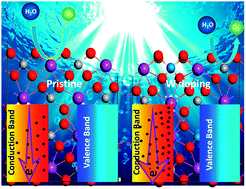An investigation on the role of W doping in BiVO4 photoanodes used for solar water splitting†
Abstract
n-Type doping has been widely employed to enhance the performance of a photoanode in a photoelectrochemical cell used for water splitting. However, little is known about how doping affects the catalytic activity during surface catalysis. Herein, we took BiVO4 as an example to investigate the effect of doping on surface catalysis from both experimental and theoretical perspectives. To enable an impartial comparison, we have prepared planar BiVO4 thin films with and without W doping. It was found that W doping had no obvious effect on the morphology, crystallinity, and light absorption of the film; however, the photocurrent was significantly enhanced upon W doping. This enhancement is contributed by two important factors: better charge separation efficiency and improved surface charge transfer efficiency. Electrochemical analysis reveals that W doping lowers the surface charge transfer resistance and forms active surface states, facilitating charge transfer. Theoretical analysis shows that W doping activates the V atoms to be reactive sites. Moreover, the adsorption energies and distance between adsorption species (OHads, Oads, and OOHads) involved in the water splitting process become more favorable for surface charge transfer. The current study provides an insight into the roles of W doping in BiVO4, especially during surface catalysis.



 Please wait while we load your content...
Please wait while we load your content...